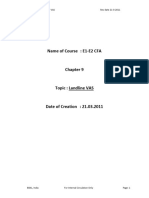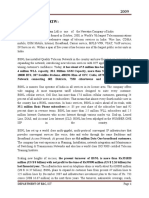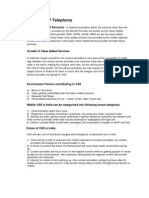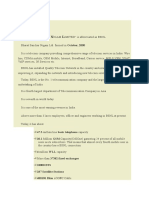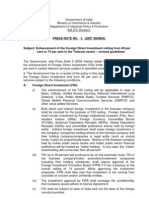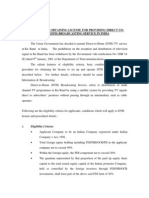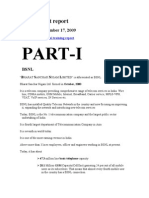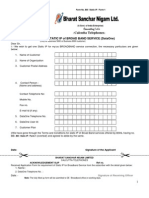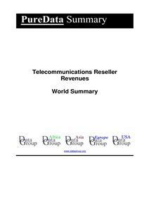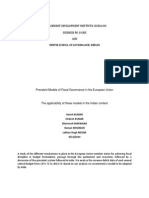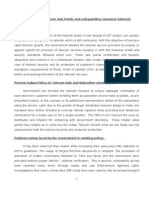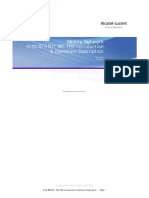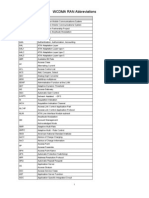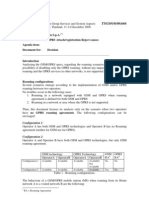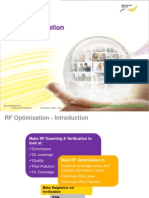-
Professional Documents
-
Culture Documents
Technical Note On Illegal International Long Distance Telephone Exchange in India
Uploaded by
Harish KumarOriginal Title
Copyright
Available Formats
Share this document
Did you find this document useful?
Is this content inappropriate?
Report this DocumentCopyright:
Available Formats
Technical Note On Illegal International Long Distance Telephone Exchange in India
Uploaded by
Harish KumarCopyright:
Available Formats
TECHNICAL NOTE ON ILLEGAL INTERNATIONAL LONG DISTANCE TELEPHONE EXCHANGE IN INDIA In India the telecom licenses has been
granted under the section 4 of the Indian Telegraph act under the following categories: a. Access Service providers : It covers the Mobile Telecom Service providers based on GSM , CDMA technology and Fixed Telephone Service Providers i.e. Traditional POTS b. International Long Distance Service Provider : Also know as ILD providers . they are international carriers and are permitted to establish International gateway , Landing Station and are authorized to carry all telecom traffic including Voice and Data to/from Indian Territory from/to the foreign countries. c. National Long Distance Service Providers : also known as NLD provider. They are authorized to carry the Domestic Telecom Traffic including Voice and Data from/to one state/Circle to/from another. d. VSAT Telecom Providers : They are authorized to provide the VSAT services for CUG and Captive network. e. INMARSAT/GMPCS providers f. Internet Service Providers : Also known as ISP. They are authorized to provide the Internet Services including Internet Telephony and other services mainly Colocation , Webhosting , Data Centre etc. The government took a conscious decision to charge a nominal license fee of Rupee One from the ISP in order to usher the benefits of Internet Connectivity. It was expected that all sizes of companies varying from startups to large established companies will be participating in the internet revolution. In accordance with NTP 1994, the telephony sector was opened for Private Companies for providing Access Services and later after NTP-99 the private service providers are permitted to offer carrier services for domestic and international traffic. Keeping in view of the interest of the Access Service Providers and International Long Distance Operators the Internet telephony was permitted to the ISP with restrictions. Internet Telephony is considered to be different service in its scope, nature and kind from real time voice as offered by other Access Service Providers and Long Distance Carriers. Hence the following type of Internet Telephony are permitted in India : (a) PC to PC; within or outside India (b) PC / a device / Adapter conforming to standard of any international agencies like- ITU or IETF etc. in India to PSTN/PLMN abroad. (c) Any device / Adapter conforming to standards of International agencies like ITU, IETF etc. connected to ISP node with static IP address to similar device / Adapter; within or outside India. (d) Except whatever is described in condition (ii) above, no other form of Internet Telephony is permitted.
(e) In India no Separate Numbering Scheme is provided to the Internet Telephony. Presently the 10 digit Numbering allocation based on E.164 is permitted to the Fixed Telephony , GSM, CDMA wireless service. For Internet Telephony the numbering scheme shall only conform to IP addressing Scheme of Internet Assigned Numbers Authority (IANA). Translation of E.164 number / private number to IP address allotted to any device and vice versa, by ISP to show compliance with IANA numbering scheme is not permitted. (f) The Internet Service Licensee is not permitted to have PSTN/PLMN connectivity. Voice communication to and from a telephone connected to PSTN/PLMN and following E.164 numbering is prohibited in India. Due to the licensing restrictions and regulations the INTERCONNECITON between the PSTN/PLMN NETWORK and INTERNET in NOT PERMITTED in India. The technical note given below explains the operation of illegal/ unauthorized setup for Incoming International Calls into India through illegal automatic ILD setup. MODUS OPERANDI OF ILLEGAL ILD TELEPHONE EXCHANGE: DEFINITIONS 1. ADC means Access Deficit Charge For all ILD calls to fixed line, terminating service provider is to be paid the access deficit amount by the ILDO. For all ILD outgoing and incoming calls from/ to cellular and WLL (M), the ADC is to be collected by the ILDO and paid to BSNL. The ADC at present is Rs. 4.25/- per minute (subject to change by TRAI) 2. BSO, CMSP, ILDO and NLDO respectively mean the Basic Service Operator, Cellular Mobile Service Provider, International Long Distance Operator and National Long Distance Operator. 3. TRAI means Telecom Regulatory Authority of India 4. Originating/ Transit/ Terminating Service Provider means the Service provider whose network is used for originating/ transit/ terminating a telecommunication message (voice and non voice) respectively. 5. Terminating Network means the network to which a receiver of a telecommunication message (voice and non-voice) is proximately connected to.
1. Basic Network- Legal Setup : EXCHANGE at Foreign End International carrierr
EXCHANGE in India
International Carrier
In the authorized/ legal setup for international calls, the foreign subscriber (A-number) dials the desired destination number in India (B-number). His call is carried from the foreign exchange to the Indian exchange through some authoriesd international carrier at foreign end (e.g. AT&T, MCI,BT), then through some authorised carrier in India (e.g. VSNL, Bharti, Reliance). In this case the authorised ILD operator in India (VSNL, Reliance, Bharti) earn the revenue @ around 6.98 Rs (15 cents) per minute from their foreign counterpart and they pay ADC (as per TRAI regulation) per minute to BSNL. 2. Basic Network- Illegal Setup: EXCHANGE at Foreign End VOIP GATEWAY at foreign end ISP at foreign end
EXCHANGE in India
VOIP GATEWAY in India
ISP in India
The setup consists of an exchange in the foreign country from which the calls are being made in India. The subscribers at foreign end (A-Number) dial the desired destination
number (B-Number). The call is converted into data form by a VOIP Gateway. This data is transmitted to India over international leased lines provided by ISP (internet service provider) at foreign end, then through the ISP in India to the VOIP Gateway in India. This VOIP Gateway is connected to the illegal exchange in India. The data received by the VOIP Gateway is converted back into voice call and transferred to the illegal exchange. The illegal exchange automatically dials the B-number and the call is matured. In this case, the final dialing is done by the exchange in India, so the CLI (calling line identification) number displayed on the B-subscriber is the exchange number of Indian illegal exchange. INFRINGEMENT OF RULES a. The above illegal setup bypasses the international carriers (VSNL, Bharti, etc), authorised to carry international calls into the country, thus robbing them of the lawful revenue, they are authorised to earn (around 15 cents per minute). b. On all international calls carried by the authorised carriers, an ADC (as per TRAI regulation) per minute is earned by BSNL. Since the voice calls carried through VOIP setup are bypassing the authorised operators, the Government is being robbed of the ADC on incoming international calls, amounting to stealth. c. Violation of Rule 4 of Indian Telegraph Act: Within India, the Central Government shall have exclusive privilege of establishing, maintaining and working telegraphs: Provided that the Central Government may grant a license, on such conditions and in consideration of such payment as it thinks fit, to any person to establish, maintain or work a telegraph within any part of India. Since the illegal setups are working without any license from the Government of India, they are violating the above rule. d. As the illegal setups can not be monitored, they are possible threats to the security of nation.
On example of operation of such illegal Exchange at SCF 182, Grain Market, Sec 26, Chandigarh Punjab raided by TERM Cell DOT New Delhi is given below : The illegal exchange that was working at second floor of SCF 182, Sector 26, Grain Market, Chandigarh was working with the reliance FWTs. The operation of the exchange is explained below: At the foreign end, a subscriber makes a call to the desired destination number in India. His call is taken by an exchange in the foreign country. A number of such simultaneous calls are combined in one T1 stream (Multiplexed) through a T1 multiplexer at the foreign end. This T1 stream is sent to the VOIP gateway placed at the foreign end and converted to data. This data is transmitted to the VOIP gateway placed in India. The internet connectivity for transmission of this data to India is provided by some ISP (Internet Service Provider) in foreign country while the same data is carried to the VOIP gateway in India through some ISP in India. The medium for transmission is VSAT (Very Small Aperture Terminal). The output of VSAT is amplified in the power amplifier and the RF unit. The output of RF unit is given to VOIP gateway (of Neura Communication) and converted to voice. This is then demultiplexed (separated in individual calls) in the T1 CAC multiplexer. The separated calls are then transited automatically to the desired destination through the reliance FWT and so the local number of the reliance FWT is displayed on the phone of the final destination subscriber.
Harish Kumar, R/o Gangwar Colony Nawabganj, Bareilly, Uttar Pradesh , India Email id. Harish_gang@yahoo.com Disclaimer : I hereby declare that the above views are my own and not those of the
Government. of India.
You might also like
-
Overview of Some Voice Over IP Calls and SMS Verifications Services ProvidersFrom EverandOverview of Some Voice Over IP Calls and SMS Verifications Services ProvidersNo ratings yet
-
Wireless Telecommunications Carrier Revenues World Summary: Market Values & Financials by CountryFrom EverandWireless Telecommunications Carrier Revenues World Summary: Market Values & Financials by CountryNo ratings yet
-
Guidelines DOTDocument 7 pagesGuidelines DOTganusivNo ratings yet
-
"TRAI Regulations''Document 6 pages"TRAI Regulations''Vaibhav Mandhare50% (2)
-
Communicate Freely With Legal VoIP in IndiaDocument 14 pagesCommunicate Freely With Legal VoIP in IndiaAnoyNo ratings yet
-
Communicate Freely!: One Simple Solution For All Your Communication NeedsDocument 14 pagesCommunicate Freely!: One Simple Solution For All Your Communication NeedsAnoyNo ratings yet
-
Govt Simplifies ILD and NLD Licences, Reduces FeesDocument 3 pagesGovt Simplifies ILD and NLD Licences, Reduces Feesanubhav777No ratings yet
-
Chapter-15 More On BSNL Services: Data OneDocument 34 pagesChapter-15 More On BSNL Services: Data Onesureshknit03No ratings yet
-
J K FTTH Revised Sample AgreementDocument 10 pagesJ K FTTH Revised Sample AgreementSDE KTWNo ratings yet
-
Landline VASDocument 8 pagesLandline VASDhanushPNo ratings yet
-
Map SignalingDocument 30 pagesMap SignalingAmit. K.No ratings yet
-
IKF Technologies Limited customer order form for internet lease line serviceDocument 5 pagesIKF Technologies Limited customer order form for internet lease line serviceskikhtiarNo ratings yet
-
Regulation 20 Nov 09Document 15 pagesRegulation 20 Nov 09ruzbehrajaNo ratings yet
-
BSNL Training: E10B and TAX ExchangesDocument 16 pagesBSNL Training: E10B and TAX ExchangesAshutosh SinghNo ratings yet
-
Rebate for telecom services to foreign roamersDocument 3 pagesRebate for telecom services to foreign roamersReshmi VarmaNo ratings yet
-
Manual of Practice For Handling Consumer Complaints: (A) Name and Address of The Service ProviderDocument 15 pagesManual of Practice For Handling Consumer Complaints: (A) Name and Address of The Service ProviderAbha TrivediNo ratings yet
-
INDIA TELECOM INDUSTRY OVERVIEWDocument 21 pagesINDIA TELECOM INDUSTRY OVERVIEWBhupendra SharmaNo ratings yet
-
BPO guildlines reserch with refrencesDocument 5 pagesBPO guildlines reserch with refrencesFaaiz siddiquiNo ratings yet
-
FTTH OnM Manual PDFDocument 25 pagesFTTH OnM Manual PDFanilhapur100% (1)
-
Taxation of Non-Residents With Special Reference To Chapter Xii and Xii ADocument 16 pagesTaxation of Non-Residents With Special Reference To Chapter Xii and Xii APJ 123No ratings yet
-
Telecom Industry in IndiaDocument 11 pagesTelecom Industry in IndiaV.vinay Kumar GuptaNo ratings yet
-
BSNL Data AnkitDocument 30 pagesBSNL Data Ankitguptaekta20No ratings yet
-
Bharat Sanchar Nigam Limited (A Government of India Enterprise)Document 14 pagesBharat Sanchar Nigam Limited (A Government of India Enterprise)uma shankarNo ratings yet
-
ILDO Concept From TRAIDocument 12 pagesILDO Concept From TRAIvasanthkumar18No ratings yet
-
DNIT WiFiHotSpot Rural T588 28062017Document 9 pagesDNIT WiFiHotSpot Rural T588 28062017hd99054No ratings yet
-
PSTN Network and Services OverviewDocument 21 pagesPSTN Network and Services OverviewYemmanAllibNo ratings yet
-
Guidelines For The Implementation and Provision of Voice Over Internet Protocol (Voip) ServicesDocument 4 pagesGuidelines For The Implementation and Provision of Voice Over Internet Protocol (Voip) ServicesPeter LwandaNo ratings yet
-
VISP Contract KAza PLCDocument 32 pagesVISP Contract KAza PLCfishNo ratings yet
-
Short Code Allocation ProcedureDocument 3 pagesShort Code Allocation ProcedureMohsin KhanNo ratings yet
-
TRAI CP Paper Answers by TEMA IndiaDocument 4 pagesTRAI CP Paper Answers by TEMA IndiadeeepkaNo ratings yet
-
Comparative analysis of prepaid call ratesDocument 58 pagesComparative analysis of prepaid call ratesRohitashva KumarNo ratings yet
-
TRAI RegulationsDocument 2 pagesTRAI RegulationsBasavaraju K RNo ratings yet
-
Call Centre GuidelinesDocument 15 pagesCall Centre GuidelinesNaosher Md ZakariyarNo ratings yet
-
Rohit Goel - 236Document 3 pagesRohit Goel - 236Rohit GoelNo ratings yet
-
Memorandum Order No 3-11-2005Document 28 pagesMemorandum Order No 3-11-2005von kervy onradeNo ratings yet
-
BSNL: India's largest telecom service providerDocument 27 pagesBSNL: India's largest telecom service provideryeshu100% (1)
-
RFP For ATM/BRANCH Connectivity Using VSAT/CDMA/RF/FWT: Punjab National BankDocument 23 pagesRFP For ATM/BRANCH Connectivity Using VSAT/CDMA/RF/FWT: Punjab National BankioeuserNo ratings yet
-
Penalities and AdjudiationDocument 23 pagesPenalities and AdjudiationHARSHIT KUMARNo ratings yet
-
Government of India Raises FDI Cap in Telecom to 74Document 4 pagesGovernment of India Raises FDI Cap in Telecom to 74Pari BasuNo ratings yet
-
07b.international RoamingDocument 10 pages07b.international RoamingSree ViharikaNo ratings yet
-
New Proposal Format Version 2.1.2Document 9 pagesNew Proposal Format Version 2.1.2Ulaganayagan KamalNo ratings yet
-
PostpaidTariffNotificationFV PDFDocument 21 pagesPostpaidTariffNotificationFV PDFmeleseNo ratings yet
-
Wings PPT For Call Centre & CSCsDocument 12 pagesWings PPT For Call Centre & CSCsamitkrayNo ratings yet
-
Illegal Telephone ExchDocument 2 pagesIllegal Telephone ExchRaj SharmaNo ratings yet
-
Guidelines For Obtaining License For Providing Direct-To-Home (DTH) Broadcasting Service in IndiaDocument 26 pagesGuidelines For Obtaining License For Providing Direct-To-Home (DTH) Broadcasting Service in IndiaTanveer ShaikhNo ratings yet
-
BSNL Telephone KnowledgeDocument 27 pagesBSNL Telephone KnowledgeiamsudhirkrishnaNo ratings yet
-
Monthly Report 2Document 22 pagesMonthly Report 2khalid hussenNo ratings yet
-
JudgmentDocument 99 pagesJudgmentShahbaz AlamNo ratings yet
-
Guidelines For Obtaining License For Providing Direct-To-Home (DTH) Broadcasting Service in India (As Amended Upto 6.11.2007)Document 28 pagesGuidelines For Obtaining License For Providing Direct-To-Home (DTH) Broadcasting Service in India (As Amended Upto 6.11.2007)Karthik VaratharajanNo ratings yet
-
Indian Telecommunication SectorDocument 37 pagesIndian Telecommunication SectorDHEERAJJAIN5600No ratings yet
-
BSNL ReportDocument 65 pagesBSNL ReportSakshi JaryalNo ratings yet
-
Static IP-Form and ConditionDocument 4 pagesStatic IP-Form and Conditionasumeet81No ratings yet
-
Definitions Telecommunication 2007Document 4 pagesDefinitions Telecommunication 2007AnonymousNo ratings yet
-
Ei GSM IcbDocument 11 pagesEi GSM IcbwimaxaaabglNo ratings yet
-
023 TrainingDocument 37 pages023 TrainingLaserNo ratings yet
-
Proposed Bangladesh Short Code ProcedureDocument 2 pagesProposed Bangladesh Short Code Procedurekrul786No ratings yet
-
STD & ISD SeriveDocument 2 pagesSTD & ISD Serivewarezisgr8No ratings yet
-
What Is SIMBOX?Document 6 pagesWhat Is SIMBOX?Ayoub ZahraouiNo ratings yet
-
Telecommunications Reseller Revenues World Summary: Market Values & Financials by CountryFrom EverandTelecommunications Reseller Revenues World Summary: Market Values & Financials by CountryNo ratings yet
-
Prevalent Models of Fiscal Governance in The European Union The Applicability of These Models in The Indian ContextDocument 19 pagesPrevalent Models of Fiscal Governance in The European Union The Applicability of These Models in The Indian ContextHarish KumarNo ratings yet
-
Call Spoofing Services, Modus Operandi, Regulatory Framework and Impact On SocietyDocument 9 pagesCall Spoofing Services, Modus Operandi, Regulatory Framework and Impact On SocietyHarish KumarNo ratings yet
-
Hosted Contact / Call Center Services in Indian Telecommunications Licensing and RegulationDocument 17 pagesHosted Contact / Call Center Services in Indian Telecommunications Licensing and RegulationHarish KumarNo ratings yet
-
Policy On Registration of Telecom Sales PointDocument 4 pagesPolicy On Registration of Telecom Sales PointHarish KumarNo ratings yet
-
UCP-Protokoll Emi4 1Document 52 pagesUCP-Protokoll Emi4 1userppNo ratings yet
-
Huawei ELTE Broadband Trunking ProductsDocument 25 pagesHuawei ELTE Broadband Trunking ProductsDave Jones0% (1)
-
Umts Signaling 111128180007 Phpapp02 Libre PDFDocument 375 pagesUmts Signaling 111128180007 Phpapp02 Libre PDFRasyidi UsmanNo ratings yet
-
Umts Architecture OverviewDocument 28 pagesUmts Architecture OverviewJohn Mack100% (1)
-
AoIP With Multipoint A-InterfaceDocument 22 pagesAoIP With Multipoint A-InterfaceSugi AristyoNo ratings yet
-
3G KPI Formula Ericsson NSN Huawei###Document 97 pages3G KPI Formula Ericsson NSN Huawei###Wahyu KurniawanNo ratings yet
-
MC-TRX Intro, HW Descr PDFDocument 32 pagesMC-TRX Intro, HW Descr PDFady10arNo ratings yet
-
Ewsd v16Document 89 pagesEwsd v16Eugen BleulerNo ratings yet
-
07 GU - OC2021 - E03 - 1 GUL UniRAN Configuration 65PDocument 65 pages07 GU - OC2021 - E03 - 1 GUL UniRAN Configuration 65PjedossousNo ratings yet
-
(Huawei) WCDMA RAN AbbreviationDocument 18 pages(Huawei) WCDMA RAN Abbreviationfofinho1No ratings yet
-
ZTE UMTS Idle Mode and Common Channel Behavior Feature Guide - V8.5 - 201312Document 147 pagesZTE UMTS Idle Mode and Common Channel Behavior Feature Guide - V8.5 - 201312Faiz Salih Maebed100% (2)
-
ZTE - UMTS Radio ParameterDocument 100 pagesZTE - UMTS Radio ParameterZeljko Vrankovic100% (5)
-
Ts 123122v110400pDocument 48 pagesTs 123122v110400pKranthi Kumar GuduruNo ratings yet
-
MSC Pool VMS6 PresentationDocument 101 pagesMSC Pool VMS6 Presentationnguyenmanhcuong3No ratings yet
-
TS 25.304. User Equipment (UE) Procedures in Idle Mode and Procedures For Cell Reselection in Connected ModeDocument 46 pagesTS 25.304. User Equipment (UE) Procedures in Idle Mode and Procedures For Cell Reselection in Connected ModeMạnh Lê SỹNo ratings yet
-
Iphone (Vladimir) ConsoleDocument 534 pagesIphone (Vladimir) ConsolevladimirNo ratings yet
-
Femtocells Technologies and Deployment.9780470742983.51847Document 329 pagesFemtocells Technologies and Deployment.9780470742983.51847Rakesh Jha100% (4)
-
MX OneDocument 4 pagesMX OneDonald AbidjoNo ratings yet
-
Test CaseDocument 177 pagesTest CasePradeep DhoteNo ratings yet
-
3GPP TS 22.011Document 26 pages3GPP TS 22.011santanameroNo ratings yet
-
Ei GSM Ericsson) Bts atDocument 5 pagesEi GSM Ericsson) Bts atGayan IndikaNo ratings yet
-
3gPP Specs GPRS Error Causes Before CC14Document 3 pages3gPP Specs GPRS Error Causes Before CC14Iftikhar Safavi SyedNo ratings yet
-
Ts 131102v120500p PDFDocument 246 pagesTs 131102v120500p PDFmalli gaduNo ratings yet
-
3G RF Opt ProcessDocument 142 pages3G RF Opt Processanand111m100% (6)
-
LTE Huawei PDFDocument 34 pagesLTE Huawei PDFPranab50% (2)
-
UMTS IRAT OptimizationGuidelineDocument 52 pagesUMTS IRAT OptimizationGuidelineMohamed Abdel MonemNo ratings yet
-
EVENTOS Cellocator Wireless Communication ProtocolDocument 292 pagesEVENTOS Cellocator Wireless Communication ProtocolWilson Geovanny Cabezas Tapia50% (2)
-
Internet Telephony LceDocument 34 pagesInternet Telephony LceJaya KrishnaNo ratings yet
-
1 OAS025101 SG7000 System Overview ISSUE1.00Document 54 pages1 OAS025101 SG7000 System Overview ISSUE1.00oscaanzcNo ratings yet









